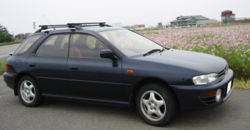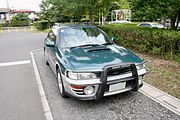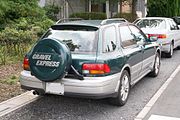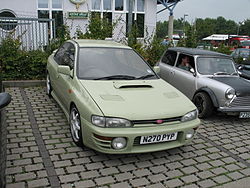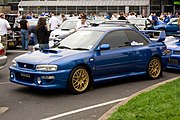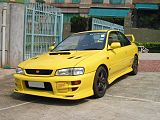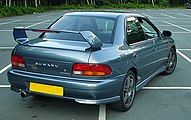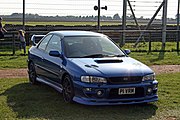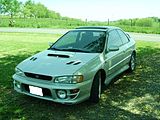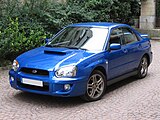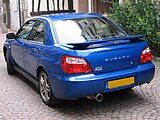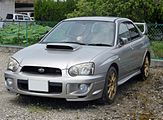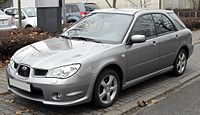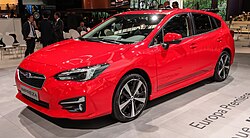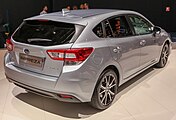Subaru Impreza
| Subaru Impreza | |
|---|---|
| Production period: | since 1992 |
| Class : | Compact class |
| Body versions : | Sedan , hatchback , station wagon , coupe |
| Previous model: | Subaru Leone |
The Subaru Impreza ( Japanese. イ ン プ レ ッ サ ) is a compact class passenger car from the Japanese manufacturer Subaru . The name comes from English impresa 'coat of arms motto ' and impression 'impression'.
The Impreza was designed to fill the gap between the big Legacy and the little Justy and was the successor to the Subaru L-series . He was also supposed to replace the legacy in the WRC . The Impreza is offered as a four-door sedan , as a five-door station wagon and, since spring 2007, also as a hatchback variant. As usual with Subaru, the majority of the vehicles were equipped with a boxer engine and permanent all-wheel drive . The four-door sedan is the sportiest model in the Impreza range. Subaru has won the Constructors' World Rally Championship with it three times in a row .
The Subaru Impreza STI was used in the Production World Rally Championship (PWRC) as part of the 2011 World Rally Championship . Hayden Paddon won the PWRC championship title early in 2011 after four wins in four participations .
Impreza (GC / GF / GFC, 1992-2000)
GC and GF are the respective letter combinations used in the two vehicle identification numbers of the Impreza platforms. GC was referring to the four-door sedan ( Sedan ) and the GFC 1995 available coupe . With GF were the five-door station wagons ( Wagon ) marked.
The VIN of the Impreza at a glance:
| Code number | meaning |
|---|---|
| G | Impreza |
| C / F | Sedan / Coupé (Gfc) / station wagon |
| 8/6/4/1 | 2.0 / 1.8 / 1.6 / 1.4 |
| A / B / C / D / E / F / G | MY92-93 / MY94-95 / MY96 / MY97 / MY98 / MY99 / MY00 |
| 2/4/5 | Two-door / four-door / five-door |
| 8/7 / E / D / S | WRX / RA / STI (from version II) / STI RA / R / 22B |
| D / P | 5-speed manual / 4-speed automatic |
Version I (1992–1995)
| Impreza ( Version I ) | |
|---|---|
|
Subaru Impreza station wagon (1992-1995) |
|
| Production period: | 1992-1995 |
| Body versions : | Limousine , station wagon |
| Engines: |
Petrol engines : 1.6–1.8 liters (66–76 kW) |
| Length: | 4350 mm |
| Width: | 1690 mm |
| Height: | 1415-1455 mm |
| Wheelbase : | 2520 mm |
| Empty weight : | |
Production of the Impreza began in Japan at the end of October 1992 , and sales began on November 2nd. The Impreza was available in twelve different versions from the start. The different models were divided into three groups. The Sedan (セ ダ ン) (four-door sedan), in the versions HX-Edition S (HX エ デ ィ シ ョ ン S), HX , CS , CF and CX , the Wagon (ワ ゴ ン) (five-door station wagon), in the versions HX-Edition S (HXエ デ ィ シ ョ ン S), HX , HX air suspension (HX エ ア サ ス), CX and CS . The sedan and wagon were available with 1.6 and 1.8 liter boxer engines, similar to the engines later available in Europe. The third group was represented by the WRX , which was available in two versions, the WRX and the lighter version as the WRX-typeRA . The abbreviation RA stands for "Race Altered", which in German means something like "Race-changed". The Impreza WRX was equipped with a 2.0-liter turbo boxer engine.
In 1993 the Impreza was officially presented in Europe . At the start of sales, there were two water-cooled 4-cylinder light metal boxer engines to choose from - a 1.6-liter engine with 66 kW (90 hp) and a 1.8-l engine with 76 kW (103 hp); The range also included two body styles: the Subaru Impreza (five-door station wagon) and the Subaru Impreza sedan (four-door sedan). The smaller engine developed a torque of 128 Nm, the 1.8-l engine 147 Nm, the acceleration varied between 11.4 and 14 seconds, depending on the equipment and model. The tires were the same for all models, 175/70 tires on 14 ″ rims were used. Even back then, unleaded super gasoline had to be filled up; Subaru stated that consumption was between 6.4 and 11.1 liters, depending on speed, equipment and model. Power steering and internally ventilated disc brakes at the front were standard on all model variants. The Impreza could be delivered in two different base coats and with four optional special finishes. The base coats comprised Arctic White (color no. 30) and Tornadorot (color no. 36). The special paint finishes, which are only available at an extra charge, included Icelandic green (metallic) (color no. 07; not available for the Impreza 1.6 LX), azure green (metallic) (color no. 41), glacier blue (metallic) (color no. 68) and cherry red (pearl effect) (color no. 09; not available for the Impreza 1.6 LX).
In Japan, the Impreza 2WD 1.6 CS limited-slip differential (2WD 1.6 CS リ ミ テ ッ ド), (for the first time equipped with air conditioning as standard) was presented in Japan . After the WRC debut in August of the same year, the demand for the WRX models rose sharply, so on October 9, 1993 Subaru announced the Impreza Wagon WRX, another WRX model variant, the first WRX wagon variant. Equipped with a 162 kW (220 PS) 2.0-liter turbo boxer engine and optionally available with a manual 5-speed or automatic 4-speed gearbox with 205/55 tires on 15 "alloy wheels it is available in four different colors.
WRX STI
The first Impreza WRX STI models began to be sold in Japan on January 20, 1994 ; they were offered as sedan and station wagon. The basis for the WRX STI (often also called Impreza WRX STI Version I , but officially it had no version number) was the Impreza WRX, which has been available for a long time. In March, the production of the STI models leveled off at around a hundred pieces per month. The WRX STI was equipped with a 2.0-liter turbo boxer engine that has an output of 184 kW and a maximum torque of 309 Nm. The vehicle mass is 1230 kg. It was one of the first Subaru cars to be equipped with the Driver's Control Center Differential (DCCD). This special center differential enables the driver to decide whether to leave the adjustment of the differential to the computer or to select the settings manually. With a rotatable controller in the center console, it can change the torque distribution between the rear and front axles of the all-wheel drive and thus have a significant influence on the road behavior of the vehicle. With the introduction of this technology, Subaru aimed again at ambitious rally drivers. Outwardly, it differed from the less powerful versions by a huge rear spoiler, large fog lights and special rims. Another characteristic of the WRX-STI is the fact that it is handcrafted. The WRX produced on the assembly line were extensively converted into a WRX-STI version by the Subaru mechanics. From version II the STI was also produced on the assembly line. The equipment of the first STI was sparse: no ventilation, no device for installing electronic devices such as car radios or the like. Subaru aimed the WRX STI at small rally teams that would have removed the unnecessary components anyway.
Special versions
Impreza GT Turbo
In 1994 Subaru released the Impreza GT Turbo in Switzerland , often also called Impreza GT Turbo Swiss , whose engine has an output of 155 kW (210 hp) and a torque of 260 Nm. The turbocharger of the Swiss GT was larger than that of the following GT models in Germany; the interior was spartan and the seats offered little lateral support. The hood was made of aluminum; Clear identifying features compared to the series models of that time were the air inlets and the air scoop on the bonnet, and the radiator grille was not covered by plastic covers. In keeping with the performance, the GT Turbo has been given a small rear wing.
Impreza "stalking"
Also in 1994, the Impreza “Pirsch” special model appeared in Europe , which was tailored to the requirements of hunters. The "Stalking" was set 195 mm higher than the series vehicles, had an underbody protection, front protection bar, load compartment protective grille, welding tubs, front foot tubs, mud flaps, bumper protective films at the rear and the obligatory "Pirsch" decor, and there were also many optional accessories for Find hunters in Subaru's “Stalking” catalog. The basis for the “stalking” was an Impreza 1.8 GL with a 5-speed “dual range” transmission.
Version II (1995–1996)
| Impreza ( Version II ) | |
|---|---|
|
Subaru Impreza station wagon (1995-1996) |
|
| Production period: | 1995-1996 |
| Body versions : | Limousine , station wagon |
| Engines: |
Petrol engines : 1.6–2.0 liters (66–85 kW) |
| Length: | 4350 mm |
| Width: | 1690 mm |
| Height: | 1415-1455 mm |
| Wheelbase : | 2520 mm |
| Empty weight : | 1115-1165 kg |
In 1995 Subaru won the first WRC title with Colin McRae in both the drivers 'and the constructors' championships. This also had an impact on the series offer. The engine range was expanded upwards, the 1.8-liter engine gave way to the new 2.0-liter boxer engine with 85 kW (115 hp) and a torque of 170 Nm. The tires used were 185/70 tires with 14 ″ rims. In addition, there were minimal model maintenance measures, for example the fenders in front of the radiator grille disappeared. The reversing lock and the new paintwork were also new from Version II, all paintwork was included in the basic price. Brilliant silver (metallic) (color no. 06) and calypso red (color no. 59) were available for all models, for the 1.6 LX were Iceland green (metallic) (color no. 07), cherry red (metallic) (color No. 09), arctic white (color no. 30), caribbean blue (metallic) (color no. 40) and mint green (metallic) (color no. 61) not available.
On January 7, 1995, Subaru presented the first Impreza Coupé in Japan, the Impreza Retna 200R Coupe (Japanese リ ト ナ). The design largely corresponded to the 1994 World Rally Car and was available in three different engine variants, with a 1.5-liter, 1.6-liter and 2.0-liter turbo engine. The 1.5-liter Impreza Retna was only available with front-wheel drive, the other two versions only with permanent all-wheel drive. All models were optionally available with manual or automatic transmission.
WRX STI
The Impreza WRX STI Version II was - unlike the previous model - an official model from Subaru and the conception and production of the models took place exclusively by Subaru Tecnica International , which is also responsible for the world rally cars. The WRX STI Ver.II was equipped as a sedan with a 2-liter, 4-cylinder turbo boxer engine with a power of 200 kW (275 hp); the curb weight was 1235 kg. The Sports Wagon WRX STI Ver. II developed 190 kW (260 PS) with a curb weight of 1270 kg. Another model variant was the WRX type RA STI Ver.II ; RA means "race altered", ie race-modified. The difference was a lower rear spoiler, the absence of air conditioning, power windows and radio, a shorter gear ratio and an air scoop on the roof. In addition, it was only available in white. Direct steering was available as an option; it weighed 35 kg less than the normal WRX STI. The type RA was aimed at the national private motorsport clubs, STI wanted to offer them a solid basis for a conversion to a Group N car.
Special versions
WRX STI Ver. II 555
On August 22, 1995, STI presented the new WRX STI Ver.II models, at the same time the WRX STI Ver.II 555 models were introduced. This is a street-legal replica of the successful world rally car from STI. The 555 model variant was available in two versions - a sedan and a sports wagon. They could only be ordered in the color WR Blue Mica with golden BBS rims, but it was optionally possible to order the cars with the decorations known from the World Rally Car. There was no limitation, but the cars were only available in Japan. Like the Type RA, these models were also aimed at national private motorsport clubs, but the 555s should serve as the basis for Group A cars.
Sports Wagon GRAVEL EX
On October 20, 1995, Subaru released the Impreza Sports Wagon GRAVEL EX ( Gravel Express ); Similar to the previously published Impreza “Pirsch” in Germany, this was a terrain variant of the Impreza. The vehicle has a higher ground clearance, front protection bars, roof rails as standard and the spare tire is always with you. The paintwork in two different colors should further clarify the difference to the road vehicles. The GRAVEL EX was equipped with a 162 kW (220 PS) WRX 2.0 l turbo boxer engine and benefited from the gravel rally experience of the STI engineers.
V-Limited
There were two limited special versions, the Impreza WRX V-Limited and the Impreza WRX STI V-Limited (the V in V-Limited stands for Victory). This special model is only available after Subaru has won a driver's or a constructor's title in the World Rally Championship. The WRX was limited to 1000 pieces and only available in white, black and WR Blue Mica. The WRX STI was limited to 555 pieces and only available in WR Blue Mica paintwork. All V-Limited models are numbered.
Version III (1996–1997)
| Impreza ( Version III ) | |
|---|---|
|
Subaru Impreza Sedan (1996-1997) |
|
| Production period: | 1996-1997 |
| Body versions : | Sedan , station wagon , coupé |
| Engines: |
Otto engines : 1.5–2.2 liters (–206 kW) |
| Length: | 4340 mm |
| Width: | 1690 mm |
| Height: | 1405 mm |
| Wheelbase : | |
| Empty weight : | |
On September 9, 1996, Subaru introduced the revised version of the Impreza. One of the new features of the Impreza Version III was the engine, which was based on the experience gained in the World Rally Championship. It was advertised as BOXER-MASTER 4 . This new engine was available as 1.5-, 1.8- and 2.0-liter with and without turbo. Later there was only a 2.2-liter engine with an output of 139 hp / 102 kW for the US market. The 2.2-liter engine was only available from model year 1997 and only in the coupe.
WRX STi
With the introduction of the Impreza WRX STi Version III there were a few changes. Among other things, the performance was increased from 275 HP (Version II) to around 300 HP. The power was later limited to 280 hp, as a "gentlemen's agreement" - a non-binding agreement among Japanese automobile manufacturers - was agreed in Japan that same year to restrict the performance of new vehicles. This limit is 206 kW.
The WRX STI Version III was 25 kg heavier than its predecessor (now 1250 kg). The vehicle could be distinguished from the production version on the outside by a larger rear spoiler and golden BBS rims.
Special versions
WRX Type R STi
Another innovation, presented on January 22, 1997, was the coupe built by Subaru based on the WRX STi Version III. This coupe was called the Subaru Impreza WRX Type R STi and was only built to order. Compared to the sedan, the Type R was lighter (1240 kg) and the body was more torsion-resistant. Only in Japan was the Type-R sold for 2,985,000 yen. It was available in blue mica, white and yellow, yellow Type R was sold in conjunction with dark rims as a signature special model. The coupe was used by Prodrive to build a WRC vehicle. This was so successfully used that Subaru was able to get the design engineer title in 1997.
WRX Type RA STi
There was a WRX Type RA STi version of both WRX-STi designs - sedan and coupé . Both vehicles had less noise insulation, a shorter gear ratio was used, and the gearbox housing was reinforced. Both have a water spray system for the charge air cooler, which increases the effectiveness of the cooler. The sedan also features an aluminum hood and grill, as well as thinner glass. The type RA became even more torsion-resistant and now weighed only 1190 kg. There was also a WRX Type RA version of the sedan , it differed from the WRX Type RA STi version (this had gold-colored rims) in the lack of a rear spoiler, the double-pipe exhaust system and the silver five-spoke rims. .
WRX STi Version III V-Limited
After winning the Constructors' World Rally Championship in 1996, Subaru produced the Impreza STI Version III V-Limited . This was available as a sedan and as a station wagon / sports wagon. Both were limited to 555 pieces each and cost 2,935,000 yen for the sedan and 2,915,000 yen for the sports wagon in Japan. All vehicles have a production number badge (e.g. 300/555) and were only available in the color mica blue.
Version IV (1997–1998)
With Version IV, Subaru presented the first major facelift of the first generation Impreza in 1997. The new Impreza received a new, more eye-catching grille, as well as a completely redesigned front bumper for all models without turbo. The rear bumper was also slightly modified and from model year 1998 the Impreza got new door panels and a new dashboard.
| Impreza ( Version IV ) | |
|---|---|
|
Subaru Impreza WRX STi (1997-1998) |
|
| Production period: | 1997-1998 |
| Body versions : | Sedan , station wagon , coupé |
| Engines: |
Petrol engines : 1.5–2.5 liters (–206 kW) |
| Length: | 4350 mm |
| Width: | 1690 mm |
| Height: | 1390 mm |
| Wheelbase : | |
| Empty weight : | 1210 kg |
Special versions
Version IV V-Limited models
Since Subaru won the constructors' title in the World Rally Championship again at the end of 1997, further V-Limited models were produced. This time there was the Impreza WRX Type RA STI V-Limited , Impreza WRX Type R V-Limited and the Impreza WRX Type R STI V-Limited . All vehicles were only available in the color Blue Mica and with gold five-spoke rims. The type RA STI V-Limited was again limited to 555 vehicles. While the WRX Type R V-Limited was limited to 1000 vehicles, the WRX Type R STI V-Limited was only delivered in March 1998.
Impreza Holzer Edition
After Armin Kremer won the German rally championship two years in a row with his “ Holzer rally team”, a Subaru factory team, in 1998 and 1999 , Subaru decided to create a small special version for this success. Subaru produced 450 vehicles of this special edition exclusively for the German market. 225 vehicles in calypso red , 225 in brilliant silver . The so-called "Holzer" was equipped with the 2 liter EJ20 engine, which made 116 HP / 85 kW. The car had some changes from the standard Impreza, such as: B. the large rear wing of the 99 GT, center console / fittings in body color, a special sports exhaust and an Eibach spring lowering. Characteristic, however, are the crossed radiator grille and fog lights, as well as the Holzer Edition "body kit".
Impreza 22B-STI version
The Impreza 22B-STI is a coupe that was sold as a souvenir for Subaru's 40th birthday and three FIA World Rally Championships won on March 16, 1998. As a study , the 22B was presented in 1997 at the Tokyo Motor Show under the name WRCar-STi . This study already had the 2.2-l engine, but with an output of 221 kW (300 hp) and a weight of 1240 kg.
The most striking features of the 22B are the unique blue paintwork and the displayed fenders, which came from the WRC car designed by Peter Stevens . The rear wing, which is also very distinctive, is fully adjustable up to the height. The 22B was limited to 424 vehicles. 400 units were sold in Japan and sold within 30 minutes to 24 hours (depending on the source). Subaru later built another 24 vehicles that were only intended for export. 16 came to Great Britain ( 22B-STi Type UK ), five cars to Australia. Unlike the normal Imprezas, the 22B is equipped with the EJ22 (2212 cm 3 ). The engine delivers 206 kW as in the serial Impreza, wherein the maximum engine speed of 8000 to 7000 min -1 was reduced. The 22B has a total weight of 1270 kg.
Colin McRaes co-driver Nicky Grist and David Lapworth from Prodrive each received a vehicle for their achievements in the World Rally Championship. These three vehicles are said to have the chassis number 000.
There is much debate about the origin of the name 22B . On the one hand it is assumed that the name is composed of the 2.2 liters (22) and the Bilstein chassis (B), on the other hand the name of 555 , the main sponsor of the WRC team (a cigarette manufacturer), could be derived from the hexadecimal value ( 555 in hexadecimal notation is 22B).
Technical specifications
| Subaru Impreza | 22B-Sti version |
|---|---|
| engine | 4-cylinder boxer engine (four-stroke) |
| Engine type | EJ22 |
| Displacement | 2212 cc |
| Bore × stroke | 96.9 mm × 75 mm |
| Power at 1 / min; | 206 kW (280 PS) at 6000 |
| Max. Torque at 1 / min; | 363 Nm at 3200 |
| compression | 8.0: 1 ± 0.2 |
| Mixture preparation | Electronic injection, turbocharger, intercooler |
| Valve control | 2 × 2 overhead camshafts, drive via toothed belt , 4 valves per cylinder |
| cooling | Water cooling |
| transmission | 5-speed transmission, permanent four-wheel drive |
| Front suspension | Wishbones, struts, coil springs |
| Rear suspension | Longitudinal and wishbones, coil springs |
| steering | Rack and pinion steering , servo-assisted |
| body | Sheet steel , self-supporting |
| Front / rear track | 1480/1500 mm |
| wheelbase | 2520 mm |
| Dimensions (four-door GT) | 4365 mm × 1770 mm × 1390 mm (4350 mm × 1690 mm × 1400 mm) |
| Empty weight | 1270 kg |
| Top speed | approx. 238 km / h |
| 0-100 km / h | approx. 4.2 s |
Version V (1998–1999)
In version V, the Impreza received minimal visual revisions, but the most noticeable are the newly revised radiator grille (now a slightly forward radiator grille instead of a "flat" one) and the larger rear wing on the GT models.
| Impreza ( Version V ) | |
|---|---|
|
Subaru Impreza 2.5RS (1998-1999) |
|
| Production period: | Sep 1998- Aug. 1999 |
| Body versions : | Sedan , station wagon , coupé |
| Engines: |
Petrol engines : 1.5–2.5 liters (–206 kW) |
| Length: | |
| Width: | |
| Height: | |
| Wheelbase : | |
| Empty weight : | |
Casa Blanca
In October 1997 Subaru presented the retro study Impreza Sport Wagon "Casablanca" (Japanese ン プ レ ッ サ ス ポ ー ツ ワ ゴ ン 「カ サ ブ ラ ン カ」); The car was based on the Impreza Version V. Initially only intended as a study, Subaru started the car under its own branding as "Casa Blanca" (model code GF-GF2) only 14 months later on December 17, 1998 in Japan due to the high demand for sale. The designation "Impreza Casablanca" or "Impreza Casa Blanca" is only correct in connection with the 1997 concept car. Subaru limited the number of vehicles to 5000 from the start. The most noticeable features were the chrome radiator grille as well as the round headlights, indicators and the rear lighting.
The Casa Blanca was only sold with the 95 hp / 70 kW (1493 cm³) EJ15 engine and automatic transmission. It was available as a sedan or station wagon, each with front or all-wheel drive. The car colors were Dark Purple Mica, Royal Blue Mica, Artic Silver Metallic and Green, and from 1999 a champagne color and Blue Mica.
Special versions
Impreza RB5
Version VI (1999–2000)
| Impreza ( Version VI ) | |
|---|---|
|
Subaru Impreza WRX (1999-2000) |
|
| Production period: | 1999-2000 |
| Body versions : | Sedan , station wagon , coupé |
| Engines: |
Petrol engines : 1.6–2.5 liters (70–206 kW) |
| Length: | 4350 mm |
| Width: | 1690 mm |
| Height: | 1415-1455 mm |
| Wheelbase : | 2520 mm |
| Empty weight : | 1155-1285 kg |
Special versions
Impreza S201-STi version
The S201 is the first vehicle of the so-called S-series from Subaru Tecnica International , which is available in a limited production of WRX STi with an output of more than 206 kW as standard. The S201, limited to just 300 vehicles, was sold in Japan on April 3, 2000. It is also the only S-series vehicle to date (2008) to be fitted with a body kit . This body kit came from the Electra One study presented in 1999 . Except for a few small things, this study was completely implemented in the S201. The rear wing used on the S201 was developed by the aerospace department at Fuji Heavy Industries and was available a few months before the S201 was sold. The S201 was only sold with a two-tone paintwork (Artic Silver Metallic / Dark Gray) and with gold six-spoke rims (17 inches).
Prodrive P1
The P1 (Prodrive One), also called Subaru Impreza P1, is based on the Impreza WRX STI Type-R Coupé, which was presented at the 1999 London Motor Show (Earls Court). The car was only available in Sonic Blue Mica. The entire engine, the electronics and the catalytic converter have been revised and, like the Type-R, it delivers 206 kW / 280 PS. The P1 weighs 1283 kg and has a top speed of 248 km / h. Prodrive originally planned to build 500 copies at a price of £ 31,495, but eventually over 1000 vehicles were produced.
In 2006 Prodrive introduced the Prodrive P2 , which was planned as the successor to the P1. But there was only one prototype.
Technical specifications
| Subaru Impreza | S201 STi version |
|---|---|
| engine | 4-cylinder boxer engine (four-stroke) |
| Engine type | EJ20 |
| Displacement | 1994 cc |
| Bore × stroke | 92 mm × 75 mm |
| Power at 1 / min | 221 kW (300 hp) at 6500 |
| Max. Torque at 1 / min | 353 Nm at 4000 |
| compression | 8.0: 1 ± 0.2 |
| Mixture preparation | Electronic injection, turbocharger, intercooler |
| Valve control | 2 × 2 overhead camshafts, drive via toothed belt , 4 valves per cylinder |
| cooling | Water cooling |
| transmission | 5-speed transmission, permanent four-wheel drive |
| Front suspension | Wishbones, struts, coil springs |
| Rear suspension | Longitudinal and wishbones, coil springs |
| steering | Rack and pinion steering , servo-assisted |
| body | Sheet steel , self-supporting |
| Front / rear track | 1470/1460 mm |
| wheelbase | 2520 mm |
| Dimensions (four-door GT) | 4375 mm × 1690 mm × 1405 mm (4350 mm × 1690 mm × 1400 mm) |
| Empty weight | 1270 kg |
| Top speed | unknown |
| 0-100 km / h | unknown |
Impreza (GD / GG, 2000-2007)
| 2nd generation | |
|---|---|
|
Subaru Impreza sedan (2000-2002) |
|
| Production period: | 2000-2007 |
| Body versions : | Limousine , station wagon |
| Engines: |
Petrol engines : 1.5–2.5 liters (77–206 kW) |
| Length: | 4399-4465 mm |
| Width: | 1694-1740 mm |
| Height: | 1440-1481 mm |
| Wheelbase : | 2520-2525 mm |
| Empty weight : | 1255-1385 kg |
1. DG A – B (2000–2002)
In the middle of 2000 (in Europe at the beginning of 2001) a new generation was introduced, which differed from the previous model mainly in a completely redesigned chassis. It also formed the basis for all subsequent models up to and including the end of production in summer 2007. With the introduction of the GD models, there was no longer any subdivision into versions.
EU version
Compared to the US model, European customers received a more powerful brake system with four-piston fixed calipers on the front axle and two-piston fixed calipers on the rear axle. The calipers are completely identical to the brake calipers used in the GC-8-STI model, but are equipped with 294 mm and 290 mm discs in the GD-A WRX. The rear crash box is omitted compared to the US model. The EJ205 open-deck engine with TD04 turbocharger is also used in the EU.
The following WRX versions were offered in Europe:
- Impreza 2.0 WRX - 160 kW (218 hp) at 5,600 rpm, 292 Nm at 3,600 rpm; Driving performance: 0–100 km / h in 6.2 s, V max 230 km / h with five-speed gearshift, 17-inch aluminum rims and rear viscous limited-slip differential, EJ205 engine, 95 octane
- Impreza 2.0 WRX STi - 195 kW (265 hp) at 6,000 rpm, 343 Nm at 4,000 rpm; Driving performance: 0-100 km / h in 5.5 s, V max 238 km / h with six-speed gearbox, 17-inch alloy wheels, front / rear limited-slip differential and sports package (spoiler, sports suspension, ABS, bucket seats), EJ207 engine, 98 octane
US version
The US models of the Subaru WRX in the GDA version differ in several points from the models in the Japanese and European markets: US models have larger and much more stable crash boxes behind the front and rear bumpers. Fixed calipers with two pistons are used in the brake system on the front axle, while floating calipers with one piston are used on the rear axle. The engine is largely based on the EU model. It is based on the EJ205 open deck with TD04 turbocharger.
JDM execution
The Japanese model of the Impreza WRX has the same braking system as it is used in the EU model, but the front crash box has been replaced by a strut that saves weight compared to the classic carrier. In addition, the Japanese WRX models use a semi-closed deck motor EJ207, which was only installed in the Impreza WRX STI in the USA and the EU. This engine differs from the EJ205 in that it has a more stable short block and forged pistons that were used from 2001 to the end of 2002. From 2003, the forged pistons were replaced by so-called hypercast pistons as part of the facelift (GD-B model). The IHI VF35 is used as the turbocharger instead of the Mitsubishi TD04.
The Japanese WRX-STI vehicle also contains the EJ207 engine installed in the WRX, but the variable valve control (AVCS) as well as a larger turbocharger and intercooler are added.
Japanese GDA-WRX models at a glance:
- Impreza 2.0 WRX - 183 kW (250 PS), EJ207 engine, 98 octane
- Impreza 2.0 WRX STi - 206 kW (280 PS) with six-speed gearbox, EJ207 engine with AVCS, 98 octane
UK version
- Impreza WRX UK 300 (2001) 300 copies of the 2001 GD-A Impreza WRX were specially converted for Great Britain by Prodrive. Features are 18 inch Prodrive / OZ alloy wheels with Pirelli Rosso P Zero tires in the dimensions 225/45 ZR18, blue Alcantara interior like the STi (but without STi emblem embroidery), UK 300 foot and trunk mat, Prodrive WRC style headlights, white side indicators and reflectors, UK 300 Prodrive front spoiler, UK 300 Prodrive rear spoiler and the striking blue WR Blue Mica paintwork. All UK 300 models were provided with a numbered UK 300 badge in the interior - the badge was affixed in different places, but preferably in the center console under the ashtray.
2. DG C – E (2002–2005)
On September 11, 2001, Revision B of the Impreza (GD) was presented at the IAA in Frankfurt. The WRX STi 195 kW was also presented.
The most striking features of this version are likely to be the new headlights and the revised taillights. The engine management of the WRX model was also modified and the output increased from 160 kW (218 PS) to 165 kW (225 PS). As a result, GD-B models require 98 octane super plus gasoline, while the engine of the GD-A model runs on normal 95 octane super gasoline.
- Impreza 2.0 GX - 92 kW (125 PS) with five-speed gearshift or automatic and 16-inch alloy wheels
- Impreza 2.0 WRX - 165 kW (225 PS) at 5,600 rpm, 300 Nm at 4,000 rpm; Driving performance: 0-100 km / h in 5.9 s, V / max 232 km / h. with five-speed gearbox, 17-inch alloy wheels and rear limited-slip differential, EJ205 engine, 98 octane
- Impreza 2.0 WRX STi - 195 kW (265 hp) at 6,000 rpm, 343 Nm at 4,000 rpm; Driving performance: 0–100 km / h in 5.5 s, V / max 238 km / h with six-speed gearbox, 17-inch alloy wheels, front / rear limited-slip differential and sports package (spoiler, sports suspension, ABS, bucket seats), EJ207 engine, 98 octane
While the GX and WRX models had driver / front passenger airbags and side airbags with integrated head airbags, the top model WRX STi did not have side airbags with integrated head airbags.
The station wagon version was available as a 1.6 GTS 70 kW (95 PS) with five-speed gearbox, otherwise like the sedan only without the WRX STi .
All GD-A – E-Turbo models meet the Euro 3 emissions standard. The last 2.0-liter turbo engines of the EJ20 series were also used in these series. Subsequent models received the EJ25 engine with a displacement of 2.5 liters.
3rd DG F – G (2005–2007)
With the introduction of the Impreza GD F in autumn 2005, there were not only external changes (including headlights, taillights and a three-part radiator grille) but also technical changes. The 1.5-l and 2.5-l engines, which were available for both the sedan and the station wagon, were new.
- Impreza 1.5R - 77 kW (105 PS) with five-speed gearshift or automatic, optionally with front-wheel drive
- Impreza 2.0R - 118 kW (160 PS) with five-speed gearshift or automatic as Active or Comfort model (differences in equipment)
- Impreza 2.5 WRX - 169 kW (230 PS) at 5,600 rpm, 320 Nm at 3,600 rpm; Performance: 0-100 km / h in 5.9 s, 230 km / h with five-speed gearshift and rear limited-slip differential, EJ255 engine (95 octane)
- Impreza 2.5 WRX STi - 206 kW (280 PS) at 6,400 rpm, 392 Nm at 4,000 rpm; Driving performance: 0-100 km / h in 5.4 s, 255 km / h with six-speed gearbox, EJ257 engine (98 octane)
All F and G models meet the Euro 4 emissions standard.
WRX 2.5 STi
The (European) Impreza WRX STi develops 206 kW (280 hp) from a four-cylinder boxer engine with a displacement of 2.5 liters and turbocharging. The intercooler sits on top of the engine (cooling through the hood on the bonnet) and ensures good responsiveness thanks to the short charge air lines. If necessary, the driver can actively spray water onto the intercooler through a nozzle in order to increase the performance through the improved intercooling (Subaru indicates a (brief) performance increase of up to three percent).
Like all Impreza, the WRX STi is also equipped with symmetrical permanent all-wheel drive . The driver also has the option of influencing the power distribution of the center differential . There are Suretrac limited- slip differentials on the front and rear axles . The power is transmitted by a six-speed manual transmission.
The chassis of the Impreza WRX STi is fully equipped with MacPherson struts . In order to keep the unsprung masses as low as possible, upside-down constructions are used. The deceleration is carried out by a Brembo brake system in conjunction with a four-channel ABS with electronic brake force distribution. The factory used ultra-high-performance summer tires ( Bridgestone Potenza RE070).
The 2.5-liter WRX STi with 206 kW understeer less than previous models due to adjustments to the suspension and tire combination. Subaru offered slightly modified models of this WRX STi with the designation "Limited Edition". This equipment variant had, among other things, a more “civil” version (silver painted light alloy wheels, additional noise insulation and a smaller rear wing). According to Subaru, this was a response to customer requests for a "more inconspicuous" appearance of the STi's.
Special versions
- Impreza S202 STi version (2002) GDB version of the WRX STi Type RA Spec-C that was only built 400 times. In addition to the Type RA Spec C characteristics, the car had a different engine control system , a titanium silencer, exclusive display instruments and a rear wing, which was atypical for Subaru. The vehicle has an output of 235 kW and was only sold in Japan for about 3,600,000 yen . The buyer could choose between four car colors: yellow, white, black and WR Blue Mica.
- Impreza Sedan WRX STi spec C TYPE RA (2004) This is the weight-reduced version of the WRX STi . The Spec-C was available from the GDA and has been reissued with every new Impreza generation (C and F) from then on. Like almost all special versions, the vehicle was only available in Japan. The Impreza Sedan WRX STi spec C TYPE RA was limited to just 300 pieces and was available in three different colors (pure white, red (special paint) and WR Blue Mica).
- Impreza S203 (2004) The S203 is an Impreza WRX STi, which has been equipped with all available parts from the STi catalog. In the Impreza S203, it was found that the rear wing can crack due to vibrations; all 516 vehicles manufactured between December 2004 and March 2005 were affected. According to STi, however, it is sufficient to replace the existing small washers with larger ones.
- WR1 Impreza (2004) After Petter Solberg had won the World Rally Championship in 2003, Prodrive produced this limited special version for Subaru UK. Prodrive developed a new performance package, with the engine output of the WR1 Impreza being increased to 235 kW (320 PS) and a torque of 420 Nm. The WR1 accelerates to 100 km / h in 4.27 s and to 160 km / h in 10.7 s. In addition, the Prodrive-WR1 received a revised chassis and anthracite-colored 18 ″ P-FF7 aluminum rims. Prodrive chose the color ice blue metallic as the unique selling point of the special version WR1. Other details such as the stainless steel grill should emphasize the special position of the WR1.
- Impreza WRX STi spec C TYPE RA 2005 (2005) New edition of the weight- reduced WRX STi , limited to 350 pieces and only available in Japan in only three different colors (pure white, premium silver metallic (special paint) and WR Blue Mica).
- Impreza S204 (2005) The S204 presented at the end of 2005 is a WRX STi, which is identical to the S203 apart from a few minor details. The vehicle is limited to 600 units and is equipped with a two-liter boxer engine (EJ20) with an output of 235 kW.
- Impreza WRX STi spec C TYPE RA-R (2006) An Impreza (GDG) modified by STi with 235 kW, which is limited to 300 pieces. The vehicle is only available in three colors: pure white, yellow (special paint) and WR Blue Mica. This special version was also only available in Japan.
- WRX STi A-Line
- WRX STi RB320 An Impreza (GDG) modified by Prodrive with 235 kW (320 PS) and 450 Nm. The vehicle was only available in the color Obsidian Black Pearl and only in the UK. This car was built in memory of WRC driver Richard Burns , who died of cancer in 2005.
Impreza (GR, 2007-2011)
| 3rd generation | |
|---|---|
|
Subaru Impreza Hatchback (2007-2011) |
|
| Production period: | 2007-2011 |
| Body versions : | Limousine , station wagon |
| Engines: |
Gasoline engines : 1.5–2.5 liters (79–221 kW) |
| Length: | 4415-4580 mm |
| Width: | 1740-1795 mm |
| Height: | 1475 mm |
| Wheelbase : | 2620-2625 mm |
| Empty weight : | 1310-1505 kg |
| Stars in the Euro NCAP - Crash Test |
|
On April 3, 2007, Subaru presented the next generation of the Impreza at the New York International Auto Show , which was available on the German market from September 9, 2007.
As before, the Impreza was available as a four-door notchback sedan ( called Impreza Anesis in Japan ) or as a five-door hatchback variant, which was presented with a 2.5-liter engine (EJ255). The vehicle was based on a shortened legacy platform. For the first time, the Impreza was also a Subaru with a diesel engine, which was also designed as a boxer engine.
The following versions were sold by Subaru in Germany:
| Model name | Displacement (cm³) | Power (kW / PS) | Drive type | transmission |
|---|---|---|---|---|
| Petrol engines | ||||
| Impreza 1.5RF | 1498 | 79/107 | Front wheel drive | 5-speed |
| Impreza 1.5R | all wheel drive | |||
| Impreza 2.0R | 1994 | 110/150 | all wheel drive | 5-speed |
| Impreza WRX STI | 2457 | 221/300 | all wheel drive | 6-speed |
| Diesel engine | ||||
| Impreza 2.0D | 1998 | 110/150 | all wheel drive | 6-speed |
The following version is also available on the Swiss market:
- WRX Impreza, 2.5-liter turbo engine with 169 kW (230 PS) and five-speed gearbox
WRX STI
The Subaru Impreza WRX STI was available in two basic equipment versions: the WRX STI and the WRX STI 17 ″ version . The normal WRX STI had 18 "cast aluminum rims (× 8 1 / 2J) in a dark gray. Forged 18 ″ BBS aluminum rims in silver (with the exception of the vehicles with the color WR Blue Mica , which only have a gold-colored coating) could be purchased as an option ; The Potenza RE050A in the dimensions 245 / 40R18 were used as tires. The 17 ″ version received 17 ″ cast aluminum rims in silver (× 8JJ), and the tires were the Potenza RE070 in the dimensions 235 / 45R17. The two versions differed only slightly. The 17 ″ version is only available in pure white and WR Blue Mica at a base price of 3,444,000 yen (3,280,000 yen excluding taxes). The normal WRX STI, on the other hand, was available in two different interior designs and in a total of seven different paintwork variants (red is a special paintwork and cost 31,500 yen surcharge), the price was 3,654,000 yen (3,480,000 yen without taxes).
In Germany, the WRX STI was available in two different versions, both of which had 221 kW (300 PS), all-wheel drive, 6-speed gearbox and 2457 cm³ in common. The Impreza WRX STI model cost 43,770 euros and the Impreza WRX STI Sport model 48,770 euros, both recommended retail prices from the manufacturer. In contrast to the standard model with 5-speed gearbox, as with all Subaru models with 6-speed gearbox, the additional off-road reduction was omitted. The only difference between the two models was the equipment, the performance should be identical. The acceleration from 0-100 km / h was specified by Subaru with 5.2 s and the top speed with 250 km / h, the maximum torque was 407 Nm at 4000 min −1 .
In early 2009, Subaru introduced the WRX STi A-Line in Japan . This should appeal to customers who want a comfortable but sporty vehicle. Compared to the standard WRX-STi, the A-line model had a 5-stage automatic with steering wheel paddles and eight-stage adjustable seats (also with leather). The well-known 2.5-liter 4-cylinder boxer with 221 kW / 300 hp was used as the engine. With the introduction of the A-Line, the body color Satin White Pearl became available. The Subaru Impreza WRX STI has only been called the WRX STI since autumn 2010. The notchback version of the WRX STI was available from model year 2011.
With a width of 82 meters, Travis Pastrana set a new world record in car long jump on New Year's Eve 2009 with the Subaru Impreza WRX STI.
Special versions
STI 20th Anniversary Edition
The Subaru WRX STI has been available as an anniversary version in Japan for some time. This special version is limited to 300 pieces and only available in three colors (white, WR Blue Mica and black). The price is 4,126,500 yen (3,930,000 yen excluding tax).
2.5T AWD WRX Celebration
For the 30th anniversary of SUBARU Schweiz AG (1979–2009), Subaru presented a special model exclusively for Switzerland on January 5th, 2009, the Impreza 2.5T AWD WRX Celebration . For 35,900 CHF this special model has been sold, the celebration contains compared to the commercially available models a 2.5 liter 4-cylinder 16V alloy boxer engine with 169 kW (230 hp) at 5200 min -1 and a maximum torque of 320 Nm at 2800 min −1 ; In addition, a manual 5-speed gearbox, driver, passenger and side airbags at the front, head airbags at the front and rear, sports seats with heated seats at the front, electronic vehicle dynamics control, cruise control and automatic air conditioning including pollen filter.
Technical specifications
| Subaru Impreza | 2.0D Active |
|---|---|
| engine | Boxer diesel (4 cylinder) |
| Displacement | 1998 cc |
| Power at 1 / min | 110 kW (150 PS) at 3600 |
| Max. Torque at 1 / min | 350 Nm at 1800–2400 |
| Mixture preparation | Common rail direct injection, charge air cooler |
| Valve control | Timing chain |
| cooling | Water cooling |
| transmission | 6-speed transmission, permanent four-wheel drive |
| Front suspension | Independent suspension |
| Rear suspension | Independent suspension |
| steering | Rack and pinion steering with electrical servo-assisted |
| body | Sheet steel , self-supporting |
| Front / rear track | 1495/1500 mm |
| wheelbase | 2620 mm |
| Dimensions | 4415 mm × 1740 mm × 1470 mm |
| Empty weight | 1410 kg |
| Top speed | approx. 205 km / h |
| 0-100 km / h | approx. 8.6 s |
| EC consumption (liters / 100 kilometers) | 5.8 l |
| Subaru Impreza | WRX STI |
|---|---|
| engine | 4-cylinder boxer engine (four-stroke) |
| Engine type | EJ25 |
| Displacement | 2457 cc |
| Bore × stroke | 99.5 mm × 79 mm |
| Power at 1 / min | 221 kW (300 PS) at 6000 |
| Max. Torque at 1 / min | 407 Nm at 4000 |
| compression | 8.2: 1 |
| Mixture preparation | Electronic injection, turbocharger, intercooler |
| Valve control | 2 × 2 overhead camshafts, drive via toothed belt , 4 valves per cylinder |
| cooling | Water cooling |
| transmission | 6-speed transmission, permanent four-wheel drive |
| Front suspension | Wishbones, struts, coil springs |
| Rear suspension | Longitudinal and wishbones, coil springs |
| steering | Rack and pinion steering , servo-assisted |
| body | Sheet steel , self-supporting |
| Front / rear track | 1530/1540 mm |
| wheelbase | 2625 mm |
| Dimensions | 4415 mm × 1795 mm × 1475 mm |
| Empty weight | 1470-1480 kg |
| Top speed | approx. 250 km / h |
| 0-100 km / h | approx. 5.2 s |
| Consumption (liters / 100 kilometers, Japanese standard) | 9.6 l |
Awards
- 2009: Top Safety Pick 2010
Impreza (2011-2018)
| 4th generation | |
|---|---|
|
Subaru Impreza hatchback (2011-2018) |
|
| Production period: | 2011-2018 |
| Body versions : | Limousine , station wagon |
| Engines: |
Petrol engines : 1.6–2.5 liters (84–221 kW) |
| Length: | 4415-4595 mm |
| Width: | 1740-1795 mm |
| Height: | 1465-1575 mm |
| Wheelbase : | 2645-2650 mm |
| Empty weight : | 1315-1524 kg |
| Stars in the Euro NCAP - Crash Test |
|
In the fall of 2011, Subaru introduced the fourth generation of the Impreza in the USA and Japan after the production vehicles were presented as a four-door notchback and a five-door hatchback on April 20 of the same year at the New York International Auto Show .
The launch on the European market was initially planned for the summer of 2012, but was not completed until April 2013. In advance, the off-road variant XV based on the new Impreza hit stores across Europe in March 2012 .
The most powerful Impreza has been on the market again since June 2014 as the WRX STI with 221 kW (300 PS).
In Japan and Europe (depending on the country), a two-liter petrol engine with 110 kW and a 1.6-l engine with 84 kW are offered as naturally aspirated engines, while only the 2.0i is available on the North American market.
Technical specifications
| Parameters | 1.6i | 2.0i | WRX (USA and Russia) | WRX STI |
|---|---|---|---|---|
| Construction period | 02/2013–01/2018 | 02 / 2015–01 / 2018 | 06 / 2014–01 / 2018 | 06 / 2014–12 / 2018 |
| Engine characteristics | ||||
| Engine type | 4-cylinder boxer gasoline engine | |||
| Mixture preparation | Manifold injection | Multipoint | Direct injection | Multipoint |
| Engine charging | - | turbocharger | ||
| Displacement | 1600 cc | 1995 cc | 1998 cc | 2457 cc |
| Max. power | 84 kW (114 hp) at 5600 rpm | 110 kW (150 PS) at 6200 rpm | 197 kW (268 hp) at 5600 rpm | 221 kW (300 PS) at 6000 rpm |
| Max. Torque | 150 Nm at 4000 rpm | 196 Nm at 4200 rpm | 350 Nm at 2400-5200 rpm | 407 Nm at 4000 rpm |
| Power transmission | ||||
| Drive, as standard | all wheel drive | |||
|
Gearbox, as standard [optional] |
5-speed manual transmission [CVT automatic transmission] |
6-speed manual transmission [CVT automatic transmission] |
6-speed manual transmission [Sport-Lineartronic] |
6-speed manual transmission |
| Readings | ||||
| Top speed | 185 km / h [179 km / h] |
193 km / h [193 km / h] |
215 km / h [240 km / h] |
255 km / h |
| Acceleration, 0-100 km / h | 12.3 s [12.6 s] |
10.5 s [11.1 s] |
6.0 s [6.3 s] |
5.2 s |
| Fuel consumption over 100 km (combined) | 6.2 l super [5.9 l super] |
6.9 l super [6.5 l super] |
9.2 l super [8.6 l super] |
10.4 l Super Plus |
| CO 2 emissions (combined) | 144 g / km [136 g / km] |
159 g / km [149 g / km] |
213 g / km [199 g / km] |
242 g / km |
| Emission standard according to EU classification | 5 euro | Euro 6 | 5 euro | Euro 6 |
| Empty weight | 1315–1320 kg [1350–1355 kg] |
1480 kg [1520 kg] |
1469–1504 kg [1527–1562 kg] |
1524-1537 kg |
| Tank capacity | 55 l | 55 l | 60 l | 60 l |
Impreza (since 2016)
| 5th generation | |
|---|---|
|
Subaru Impreza Hatchback (since 2016) |
|
| Production period: | since 2016 |
| Body versions : | Limousine , station wagon |
| Engines: |
Gasoline engines : 1.6–2.0 liters (84–115 kW) Otto hybrid : 2.0 liters (110 kW + 12.3 kW) |
| Length: | 4460-4625 mm |
| Width: | 1775 mm |
| Height: | 1455-1480 mm |
| Wheelbase : | 2670 mm |
| Empty weight : | 1359-1576 kg |
| Stars in the Euro NCAP - Crash Test (2017) |
|
Subaru presented a first preview of the fifth generation of the Impreza at the Tokyo Motor Show 2015 with the Impreza 5-Door Concept . The production version made its debut at the New York International Auto Show 2016. It is the first vehicle based on the new Subaru Global Platform , on which all Subaru models will be based in the future. Sales started on the Japanese home market on October 13, 2016, North America and Australia followed in December 2016. The European version made its debut at the International Motor Show in September 2017 in Frankfurt am Main . It has been delivered since January 2018. In contrast to the other markets, where the vehicle is also available as a notchback sedan, only the hatchback model is sold in Europe, at least for the time being.
Technical specifications
On the drive side, the two boxer gasoline engines familiar from the previous model are used again, with the more powerful one now producing 5 kW more. All-wheel drive is still installed as standard. A diesel variant is not offered.
| Parameters | Hatchback 1.6i | Hatchback 2.0i | Hatchback 2.0ie |
|---|---|---|---|
| Construction period | since 01/2018 | 01 / 2018-08 / 2018 | since 04/2020 |
| Engine characteristics | |||
| Engine type | 4-cylinder boxer gasoline engine | 4-cylinder boxer gasoline engine + electric motor | |
| Mixture preparation | Multipoint manifold injection | Direct injection | |
| Engine charging | - | ||
| Displacement | 1600 cc | 1995 cc | |
| Compression ratio | 11.0: 1 | 12.5: 1 | |
| Max. Internal combustion engine power | 84 kW (114 hp) at 6200 rpm | 115 kW (156 hp) at 6000 rpm | 110 kW (150 PS) at 5600-6000 rpm |
| Max. Power driving electric motor | - | 12.3 kW (16.7 PS) | |
| Max. Internal combustion engine torque | 150 Nm at 3600 rpm | 196 Nm at 4000 rpm | 194 Nm at 4000 rpm |
| Max. Electric motor driving torque | - | 66 Nm | |
| Power transmission | |||
| Drive, as standard | all wheel drive | ||
| Gearbox, as standard | Lineartronic | ||
| Readings | |||
| Top speed | 180 km / h | 205 km / h | 192 km / h |
| Acceleration, 0-100 km / h | 11.8 s | 9.8 s | 10.0 s |
| Fuel consumption over 100 km (combined) | 6.2–6.6 l super | 6.6–7.0 l super | 6.3 l super |
| CO 2 emissions (combined) | 140-151 g / km | 152-159 g / km | 143 g / km |
| Emission standard according to EU classification | Euro 6c (since 06/2018: Euro 6d-TEMP) |
Euro 6c | Euro 6d |
| Empty weight | 1359-1402 kg | 1379-1424 kg | 1553-1576 kg |
| Tank capacity | 50 l | 48 l | |
Tuning
Subaru's house tuner STI ( Subaru Tecnica International ) has not only produced the well-known WRX-STI version and special models since the start of production of the Impreza, but also a large number of tuning and motorsport parts that further increase the potential of the Impreza. The Impreza is also popular with many other tuning companies. The Japanese companies JUN, Bozz Speed, Tommy Kaira (M20b, M20b-2.2), Pleasure Racing Service and Zero / Sports as well as the US company Cobb Tuning and the British company Prodrive produce many tuning parts for the Impreza models. Furthermore, some companies offer completely modified vehicles; including the English company Litchfield with their two Type-25 and Type-20 (from 2009). Or, as at L'aunsport, WRC replica parts or complete vehicles are offered.
Movies
- The Subaru Impreza Story (DVD) Language: English (2001)
- Hyper Rev, DVD Vol. 1, Impreza , language: Japanese (2005)
- Born to Race (2011)
- Kingsman: The Secret Service , Impreza WRX STI (GD-F) , (2014)
- Nerve , Impreza WRX (GD-A), (2016)
- Baby Driver , Impreza 2.5 WRX , language: English (2017)
- Chappie (2015)
- Some Impreza WRX , play repeatedly in the film series Fast and Furious (since 2001)
swell
- Subaru Impreza WRX STI. Japanese prospectus, print number m017G022 (November 2007) (data)
literature
- English:
- Toshihiro Arai, Brian Long: Subaru Impreza: The Road Car & WRC Story. Veloce Publishing, ISBN 978-1-84584-028-0 .
- Graham Robson: Subaru Impreza (Rally Giants). ISBN 1-84584-042-9 .
- RM Clarke: Subaru Impreza WRX Performance Portfolio 2001-2005. Brooklands Books, ISBN 1-85520-706-0 .
- David Hobbs: Subaru Impreza All turbo models 1992 to 2007. Veloce Publishing, ISBN 978-1-84584-163-8 .
- Japanese:
- Hyper REV Vol. 12 Subaru Impreza. 1996.
- Hyper REV Vol. 28 Subaru Impreza No. 2. ISBN 4-938495-63-5 , 1998.
- Hyper REV Vol. 59 Subaru Impreza No. 3. ISBN 4-89107-071-4 , 2001.
- Hyper REV Vol. 74 Subaru Impreza GC8. ISBN 4-89107-147-8 , 2002.
- Hyper REV Vol. 84 Subaru Impreza GD. ISBN 4-89107-207-5 , 2003.
- Hyper REV Vol. 107 Subaru Impreza No. 4. ISBN 4-89107-365-9 , 2005.
- Hyper REV Vol. 115 Subaru Impreza No. 5. ISBN 4-89107-435-3 , 2006.
- Hyper REV Vol. 128 Subaru Imprezau No. 6. 2008.
- Impreza magazine. No. 1-40 (since 1998).
Web links
Individual evidence
- ↑ 新型 ス バ ル イ ン プ レ ッ サ を 発 表 . (PDF) Fuji Heavy Industries , November 30, 2011, accessed April 3, 2016 (Japanese).
- ↑ Results list of the PWRC races 2011 . (wrc.com, September 11, 2011; accessed September 18, 2011)
- ↑ Subaru pedigree 1992 (Japanese) ( Memento from April 29, 2009 in the Internet Archive )
- ↑ Subaru pedigree 1992: The new Impreza (Japanese) ( Memento from November 12, 2007 in the Internet Archive )
- ↑ Illustration of the first two Impreza body versions available in Germany. (1993) ( page no longer available , search in web archives )
- ↑ Impreza four-wheel drive. The program. (1993) (pdf; 1.2 MB) ( Memento from September 20, 2009 in the Internet Archive )
- ↑ Subaru pedigree 1993 (Japanese) ( Memento from April 13, 2009 in the Internet Archive )
- ↑ Impreza Wagon WRX, entry at cars-directory.net (eng.)
- ↑ Subaru Impreza WRX-STI publication (entry in Subaru pedigree) (Japanese) ( page no longer available , search in web archives )
- ↑ Subaru Deutschland Techniklexikon: DCCD - Driver's Control Center Differential ( Memento from February 3, 2010 in the Internet Archive )
- ↑ Subaru Drive Performance: DCCD - Driver Controlled Center Differential (eng.) ( Memento from May 13, 2008 in the Internet Archive )
- ↑ Pictures of the Subaru Impreza GT Turbo Swiss
- ↑ Illustration of the Legacy "Hubertus" and the Impreza "Pirsch". (1994) ( Memento from October 9, 2012 in the Internet Archive )
- ↑ The new Subaru program for hunters. Legacy "Hubertus" and Impreza "Pirsch" (1994). ( Page no longer available , search in web archives ) (pdf; 1.2 MB)
- ↑ Impreza four-wheel drive. The program (1995). ( Memento from September 20, 2009 in the Internet Archive ) (PDF; 1.2 MB)
- ↑ Subaru Impreza illustration (1995) ( Memento from October 9, 2012 in the Internet Archive )
- ↑ Subaru Spirit pedigree, Impreza Ritona 1.5 2WD ( page no longer available , search in web archives )
- ↑ WRX STI Ver.II at Subaru-Impreza.de
- ↑ Picture gallery of the Impreza WRX STI Version II at Subaru-Impreza.de.
- ↑ Impreza WRX STI Ver.II 555 , illustration with rally decoration.
- ↑ Impreza Sports Wagon WRX STI Ver.II 555 , illustration with rally decoration.
- ↑ Subaru Spirit pedigree ( page no longer available , search in web archives ), Impreza WRX STI Ver.II.
- ↑ Subaru Spirit pedigree ( page no longer available , search in web archives ), Impreza Sports Wagon GRAVEL EX.
- ↑ Impreza WRX STI V-Limited photography at Subaru-Impreza.de.
- ↑ Subaru Impreza WRX typeR STi version release ( Memento from March 5, 2009 in the Internet Archive ) (entry in the Subaru pedigree) (Japanese).
- ↑ Frank Göpfert - www.Subaru-Impreza.com - All EDM Turbo-Imprezas since 1994. Accessed on September 10, 2019 .
- ↑ Holzer group of companies |. Retrieved August 6, 2019 .
- ↑ Frank Göpfert - www.Subaru-Impreza.com -. Retrieved August 4, 2019 .
- ↑ Official site for the Impreza 22B (Japanese)
- ↑ Frank Göpfert - www.Subaru-Impreza.com - All EDM Turbo-Imprezas since 1994. Accessed on September 10, 2019 .
- ↑ Original press release on the Subaru Impreza Sport Wagon "Casablanca" (Japanese).
- ↑ Brochure about Casa Blanca
- ↑ Official page for the Impreza S201-STi version (Japanese)
- ↑ RE070. bridgestone.com.au, accessed March 19, 2012 .
- ↑ Official page for the Impreza S202 STi version ( Memento from May 24, 2008 in the Internet Archive ) (Japanese)
- ↑ Official site for the Impreza Sedan WRX STi spec C TYPE RA ( Memento from September 17th, 2008 in the Internet Archive )
- ↑ Equipment information for the Impreza WRX STi spec C TYPE RA, with paint information at the end of the page ( Memento from September 20, 2008 in the Internet Archive )
- ↑ Official Site for Impreza S203 ( Memento of 25 June 2010 at the Internet Archive )
- ↑ Rear wing "Self-Repair Guide" from STi ( Memento from November 16, 2008 in the Internet Archive )
- ↑ The WR1 Impreza Prodrive (English) ( Memento of 12 January 2009 at the Internet Archive )
- ↑ Official site for the Impreza WRX STi spec C TYPE RA 2005 ( Memento from September 17th, 2008 in the Internet Archive )
- ↑ Equipment information for the Impreza WRX STi spec C TYPE RA 2005, with paint information at the end of the page ( Memento from May 3, 2008 in the Internet Archive )
- ↑ Official page for the Impreza S204. ( Memento from May 3, 2010 in the Internet Archive )
- ↑ Official site for the Impreza WRX STi spec C TYPE RA-R. ( Memento from November 20, 2010 in the Internet Archive )
- ↑ The Impreza RB320 at Prodrive. ( Memento from January 11, 2009 in the Internet Archive )
- ↑ euroncap.com
- ↑ Official page for the Impreza Anesis ( Memento of October 11, 2008 in the Internet Archive ) (Japanese)
- ↑ Comparison of the WRX STI and the WRX STI 17 ″ version and listing of all optional parts ( Memento of October 26, 2007 in the Internet Archive )
- ↑ Details WRX STI 17 ″ version (2007) ( Memento from October 26, 2007 in the Internet Archive )
- ↑ Details Impreza WRX STI Japan (2007) ( Memento from October 26, 2007 in the Internet Archive )
- ↑ Details Impreza WRX STI Germany (2008) ( Memento from February 6, 2009 in the Internet Archive )
- ↑ STI - STI 20th ANNIVERSARY ( Memento from February 24, 2009 in the Internet Archive ) at subaru-sti.co.jp. Found October 29, 2008.
- ↑ Details Impreza 2.5T AWD WRX Celebration (2009) ( page no longer available , search in web archives ) (PDF; 735 kB)
- ↑ autobild.de
- ↑ autobild.de
- ↑ Result of the Subaru Impreza in the Euro NCAP crash test (2017)
- ↑ All the facts about the new Impreza. March 24, 2016, accessed September 15, 2017 .
- ↑ New Subaru Impreza coming early next year. September 14, 2017. Retrieved September 15, 2017 .
- ↑ Type 25 website ( Memento of September 2, 2007 in the Internet Archive )
- ^ Litchfield website
- ↑ Official Website of L'aunsport found on 5 June of 2009.
- ↑ Watch the film online (eng.)


